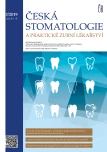The cytocompatibility of anodized surfaces for implant materials
Authors:
J. Krčil 1; V. Březina 2; J. Vaněk 3
Authors‘ workplace:
Ústav materiálového inženýrství, Fakulta strojní Českého vysokého učení technického, Praha
1; Laboratoř tkáňových kultur, Fakulta rybářství a ochrany vod Jihočeské univerzity, Nové Hrady
2; Stomatologická klinika, Lékařská fakulta Masarykovy univerzity a Fakultní nemocnice u sv. Anny, Brno
3
Published in:
Česká stomatologie / Praktické zubní lékařství, ročník 119, 2019, 3, s. 81-87
Category:
Original articles
Overview
Introduction, aim: The oxide layers on surface of titanium alloy are influencing corrosion resistance and biocompatibility. The compatibility between the bony tissue and titanium alloy is prevalently dependent on properties of a stable titanium dioxide layer. These layers can be prepared by various methods. The oxidation process (and its conditions) is resulting in different types of oxide layer: difference in chemical composition, mechanical properties, inner structure etc. The deviation inside of the layers structure may influence the stability of the layer, its adhesion or biocompatibility.
The anodic oxidation of titanium alloys in appropriate electrolyte (under certain conditions) can lead not only to creation of the oxide layer, but to creation of an oxide layer with structured surface. This kind of structure is usually characterized by pores in nanometer scale. The structured surface radically changes the interaction between the titanium alloys surface and cells; and thus influencing its behavior inside a body. The cell interaction with the structured surfaces is not properly described yet. This work aims for better understanding of such structured layers.
Methods: The anodic oxidation was carried out on Ti6Al4V ELI polished samples. The oxidation process was realized in 1M H2SO4 electrolyte with the voltage 100 V and current density 50 mA/cm2. The thickness and surface morphology of the resulting oxide layer were evaluated and documented using a scanning electron microscope (SEM). The changes of color and roughness of the surface after the oxidation were observed as well.
The cytocompatibility of the materials surface is expressed by a surface area colonized by cells after the three days of cultivation. This method is standardly used and accredited by ČIA. The MG63 cells were used for the experiment and the percentage of colonized surface area was evaluated. The evaluation was done on polished and oxidized Ti6Al4V ELI samples and the results were compared.
Result: The structure of samples prepared using the anodic oxidation consisted of pores with size ranging from tens to hundreds of nanometers.
The cytocompatibility testings showed that the cells colonized larger area on the oxidized samples. The cells covered 56.9% of the surface area of the polished samples, while 63.5% of the surface area of the anodized samples. Results of all samples exhibited Gaussian distribution.
Conclusion: The anodic oxidation lead to a creation of nanostructured oxide layer on Ti6Al4V ELI samples. The cytocompatibility of this layer was compared to polished samples. It was shown that cells are colonizing the larger surface area on the oxidized samples.
Keywords:
oxide layer – cytocompatibility – cells – MG63 – anodic oxidation
Sources
1. Yoshiki O. Bioscience and bioengineering of titanium materials. Elsevier; 2007. cit 22. červen 2019. doi: 10.1016/b978-0-08-045142-8.x5000-2. Dostupné z: https://linkinghub.elsevier.com/retrieve/pii/B9780080451428X50002
2. Zhang F, Burkel E. Novel titanium manganese alloys and their macroporous foams for biomedical applications prepared by field assisted sintering. biomedical engineering, trends in materials Science. 2011 cit. 22. červen 2019; doi: 10.5772/12874. Dostupné z: https://www.intechopen.com/books/biomedical-engineering-trends-in-materials-science/novel-titanium-manganese-alloys-and-their-macroporous-foams-for-biomedical-applications-prepared-by
3. Tolde Z, Starý V, Cvrček L, Vandrovcová M, Remsa J, Daniš S, Krčil J, Špatenka P. Growth of a TiNb adhesion interlayer for bioactive coatings. Mater Sci Eng: C. 2017; 80 : 652–658. doi: 10.1016/j.msec.2017.07.013.
4. Jirka I, Vandrovcová M, Frank O, Tolde Z, Plšek J, Luxbacher T, et al. On the role of Nb-related sites of an oxidized β-TiNb alloy surface in its interaction with osteoblast-like MG-63 cells. Mater Sci Eng: C. 2013; 33(3): 1636–1645. doi: 10.1016/j.msec.2012.12.073.
5. Godley R, Starosvetsky D, Gotman I. Corrosion behavior of a low modulus β-Ti-45%Nb alloy for use in medical implants. J Materials Sci: Mater Med. 2006; 17(1): 63–67. doi: 10.1007/s10856-006-6330-6.
6. Niinomi M, Nakai M, Hieda J. Development of new metallic alloys for biomedical applications. Acta Biomaterialia. 2012; 8(11): 3888–3903. doi: 10.1016/j. actbio.2012.06.037.
7. Gilbert J. Medical Device Materials V: Proceedings of the Materials & Processes for Medical Devices Conference 2009, August 10–12, 2009, Minneapolis, MN, USA. ASM International; 2010. 285 s.
8. Metikoš-Huković M, Kwokal A, Piljac J. The influence of niobium and vanadium on passivity of titanium-based implants in physiological solution. Biomaterials. 2003; 24(21): 3765–3775. doi: 10.1016/0376-4583(85)90077-9.
9. Cui X, Kim HM, Kawashita M, Wang L, Xiong T, Kokubo T, Nakamura T. Preparation of bioactive titania films on titanium metal via anodic oxidation. Dent Mater. 2009; 25(1): 80–86.
10. Zorn G, Lesman A, Gotman I. Oxide formation on low modulus Ti45Nb alloy by anodic versus thermal oxidation. Surface Coatings Technol. 2006; 201(3): 612–618. doi: 10.1016/j.dental.2008.04.012.
11. Bae I-H, Yun K-D, Kim H-S, Jeong B-C, Lim H-P, Park S-W, et al.
Anodic oxidized nanotubular titanium implants enhance bone morphogenetic protein-2 delivery. J Biomed Materials Res Part B: Applied Biomaterials. 2010; 93B(2): 484–491. doi: 10.1002/jbm.b.31606.
12. Homolková M, Březina V. Interakce slitiny kovu a buněčné linie. Chem Listy. 109; 2015(2): 151–154.
13. Krčil J, Mára V, Krum S, Sobotová J. The characterization of anodic oxide layers on selected bio-compatible titanium alloys. Acta Polytechnica. 2018; 58(4): 240. doi: 10.14311/AP.2018.58.0240.
14. Krčil J, Rafaj Z, Mára V, Krum S, Starý V,Nehasil V, et al.The analysis of thermal and anodic oxide layers on selected biocompatible titanium alloys. Surface Interface Analysis. 2018; 50(11): 1007–1011. doi: 10.1002/sia.6466.
15. Yang B, Uchida M, Kim H-M, Zhang X,Kokubo T. Preparation of bioactive titanium metal via anodic oxidation treatment. Biomaterials. 2004; 25(6): 1003–1010. doi: 10.1016/S0142-9612(03)00626-4.
Labels
Maxillofacial surgery Orthodontics Dental medicineArticle was published in
Czech Dental Journal

2019 Issue 3
Most read in this issue
- The bollard bone anchored miniplates in patients with skeletal class iii malocclusion
- Comparison of histopathological and clinical prognostic factors of oral squamous cell carcinomas
- The cytocompatibility of anodized surfaces for implant materials
